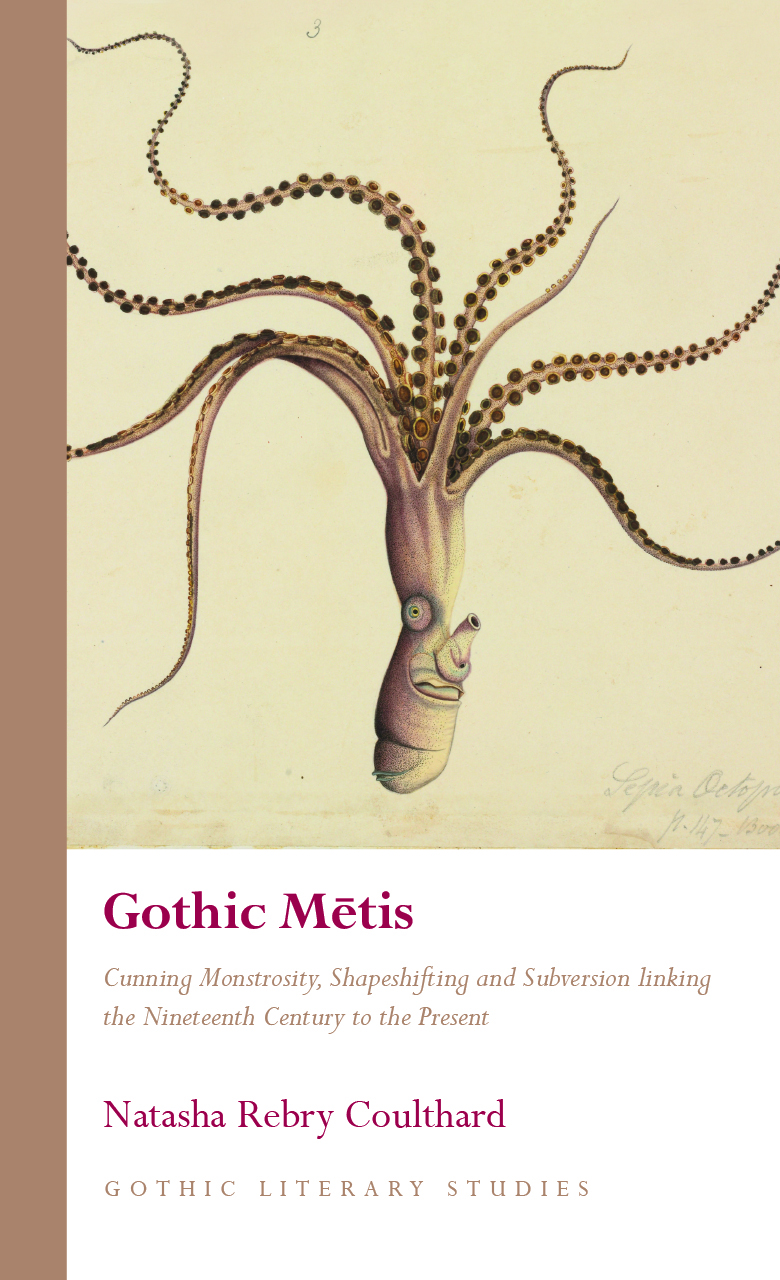Gothic Mētis
Cunning Monstrosity, Shapeshifting and Subversion linking the Nineteenth Century to the Present
Author(s) Natasha Rebry Coulthard
Language: English
Genre(s): Literary Criticism
Series: Gothic Literary Studies
- February 2025 · 280 pages ·216x138mm
- · Hardback - 9781837722136
- · eBook - pdf - 9781837722143
- · eBook - epub - 9781837722150
Exhuming and reanimating an obscure ancient cunning associated with the monstrous, the hybrid, the feminine and the nonhuman, this study proposes a novel transdisciplinary framework for analysing Gothic media and discourse through the lens of mētis. Mētis denotes a wily, adaptive intelligence shared by tricksters, humans, nonhumans and objects, characterised by shapeshifting, twists and duplicity – it is also an artful praxis for blurring categories, embracing multiplicity, navigating difference and subverting authority. Using mētis as both theme and method, Gothic Mētis weaves together myth, literature, rhetorical theory and critical posthumanism, to analyse Gothic character and narration from the nineteenth century to the present while developing a post-anthropocentric praxis for representing, navigating and ultimately subverting the Anthropocene. Reading Gothic alongside and through mētis—and mētis alongside and through Gothic—this book highlights the Gothic mode as a timely, artful response to the rise of the Anthropocene, rendering a post-anthropocentric world beyond Man.
‘Offering an original, as well as highly revealing, approach to the Gothic as inherently a “trickster” mode of cultural critique, this stunning book
delivers truly revisionist readings of major Gothic works from late Victorian-era classics to recent eco-horror films, all provocatively
analysed and theorised, in their historical contexts, as never before.’
Jerrold E. Hogle, Professor Emeritus of English and University Distinguished Professor, University of Arizona
‘Gothic Mētis uses an interdisciplinary approach to the Gothic to cover an astounding range of theoretical, cultural and textual ground. Drawing on the mythological concept of Metis and its theoretical and cultural ramifications, the text brings together such seemingly incongruous subjects as Victorian literature, microbes, rhizomes and tentacles to weave a fascinating critical web that is at once timely and innovative. This is highly recommended reading for anyone interested in Gothic theory and criticism – especially in new materialist or posthumanist approaches to the Gothic.’
Dr Anya Heise-von der Lippe, University of Tübingen
Acknowledgements
Glossary of Greek Terms
Preface: Opening Lines on Liminal Times
Introduction: Gothic Mētis: Cunning Monstrosity
The First Braid: Gothic’s Twisted Domain
Untangling the Gothic Mode
Gothic’s Twisted Forms
Gothic in the Long Long-Nineteenth Century
The Second Braid: Post-Anthropocentric Thought
Entanglements of Self and Other
Posthumans, Monsters and Others
Betwixt and ‘Between Betweens’: Liminality in Thinking and Being
The Third Braid: Mētis in Myth and Rhetoric
Metis/Mētis
The Shifting, Shimmering World
Return of the Repressed
Gothic Mētis
Chapter One: Fin de Siècle Shapeshifters and Gothic Tricksters
Fin-de-siècle Flux
Shapeshifting Gothic and Gothic Shapeshifters
Arthur Machen’s Tricksters
Snake Ladies and Shedding Skins
Assembling Mētis
Gothic Tricksters
Chapter Two: Gothic Tentacularity
Fin-de-siècle, Fin de Man
‘Precarious Man’: Evolution and Ecology in H. G. Wells
The Tentacular and Tentacularity
Dreadful Figures and Tentacular Tales: Cunning Models for the Chthulucene
Mētis, the Twisted and the Dreadful
Gothic Speculation
Chapter Three: Jekyll’s Polytropos Ethos
The Invention of Multiple Personality
The tenuous ‘I’ of Dissociative Narrative
Flexible Multiplicity
‘Gothic Psychology’ and the Multiplex Self
The Postmodern, Posthuman Polymētis
‘Fantastic, ignoble, hardly human, or frankly non-human’ Gothic Rhetoric
Chapter Four: From Hyde the Holobiont: The Monstrous Microbial Self
Tricky Microbes
‘Homo Microbis’: The Holobiont
Unsettling Man in Popular Microbiome Discourse
Seething Zoos of Microbes: Popular Microbiome Discourse
Dorion Sagan’s ‘Beautiful Monsters’
More Microbe than Man: Posthuman Gothic Framings of the Microbial Self
Contaminated Ethics
Chapter Five: Gothic Fungus: Mycorrhizae, Mētis and Monstrosity
Crypts and Creeps
A ‘study of corruption’: Arthur Machen’s ‘The Hill of Dreams’
Mētic Monsters in Gaia and In the Earth
Mētic Mycorrhizae: In the Earth
Subverting Anthropos: Gaia
The Polyplokos Monster and Mētistic Rapport
Gothic Mētis and the Ineffable More-than-Human World
Chapter Six: Gothic Mētis and More-than-Human Rhetoric
Spectres and Hauntings in Lee
Genius Loci: The Spirit of Place
Mētis and More-than-Human Rhetoric in Lee
Haunting More-than-Human Rhetoric
Gothic Environmentalism
Gothic is Always Already Eco
Postscript: Gothic Poros
Gothic Métissage
Talking with Ravens and Crows
Closing Lines on Liminal Times
References


